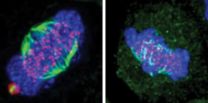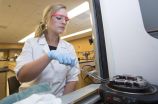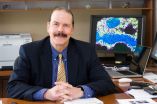(Press-News.org) An international consortium of scientists led by a group from the University of Leicester has announced a new advance in understanding the mechanisms of cancer and how to target it more effectively with new treatments.
Two papers published in the same issue of the world-leading Journal of Cell Biology have arisen from research work led by Professor Andrew Fry at the University of Leicester. Both papers suggest that new understanding of the mechanics of cell division can reveal new targets for cancer therapy.
Professor Fry, who is Director of Research in the College of Medicine, Biological Sciences and Psychology at Leicester, said: "Together, these two papers provide exciting new insights on how cells ensure that they faithfully pass on the right amount of genetic material to their offspring when they divide. They also highlight potential new targets for the development of novel cancer treatments.
"These papers identify a series of key steps that orchestrate the mechanics of cell division and highlight novel targets that could be inhibited to block cancer cell division. Through working with outstanding collaborators in Leicester and across the world, our future goal is to exploit this new understanding of the biology that underlies cell division to develop more effective medicines that will allow better treatments for patients with a wide range of cancers".
With funding from Worldwide Cancer Research, Cancer Research UK, The Wellcome Trust, BBSRC, Medical Research Council and Hope Against Cancer, a Leicestershire and Rutland-based charity, Professor Fry's group within the Department of Biochemistry at the University of Leicester has been studying the mechanics of cell division. Their aim is to gain new understanding on how this process is controlled in normal cells, how it goes wrong in cancer and how it might be targeted with drugs that can more effectively eradicate the tumour whilst causing less side-effects for cancer patients.
The first of these two papers, led by Dr Laura O'Regan, demonstrates that an enzyme called Nek6 controls the stability of the structural scaffold upon which the genetic material, encoded on chromosomes, is separated. They showed that Nek6 leads to recruitment onto this scaffold of a chaperone called Hsp70. Chaperones are proteins that act as cellular guardians folding proteins into their correct shape and assembling them into functional complexes. In the context of cancer, chaperones are particularly important as they protect cancer cells against the stressful environment of a tumour and keep them alive.
Not surprisingly then, there is growing interest from pharmaceutical companies in the development of chaperone inhibitors as novel anti-cancer therapies and the new findings provided in this paper will be key to identifying how best to use these new drugs to selectively kill cancer cells.
In the second paper, work led by Dr Suzanna Prosser demonstrated that an enzyme belonging to the same family as Nek6, in this case called Nek5, also provides a key function in enabling timely assembly of the structural scaffold required for chromosome division with loss of Nek5 leading to genetic damage.
INFORMATION:
The two papers are:
L. O'Regan, J. Sampson, M.W. Richards, A. Knebel, D. Roth, F.E. Hood, A. Straube, S.J. Royle, R. Bayliss, and A.M. Fry (2015) Hsp72 is targeted to the mitotic spindle by Nek6 to promote K-fiber assembly and mitotic progression. Journal of Cell Biology.
S.L. Prosser, N.K. Sahota, L. Pelletier, C.G. Morrison, and A.M. Fry (2015) Nek5 promotes centrosome integrity in interphase and loss of centrosome cohesion in mitosis. Journal of Cell Biology.
Geoscientists have, for the first time, discovered the origins of Australia's two largest basins: Lake Eyre and the Murray-Darling Basin. The research also implies that in 30 million years' time both basins will cease to exist.
Monash University geoscientist Associate Professor Wouter Schellart, and his colleague Professor Wim Spakman from Utrecht University, have discovered how the floor of an entire ocean basin that was destroyed 70 to 50 million years ago off the North coast of New Guinea is currently located at 800-1200km depth below Central and South-eastern Australia.
Using ...
New scanning methods which map the wiring of the brain could provide a valuable new tool to predict people at risk of schizophrenia, according to a new study.
Scientists have long known that the symptoms of schizophrenia are partly explained by disordered connectivity in the brain.
Now, a team of scientists from Cardiff University Brain Research Imaging Centre (CUBRIC), the Institute of Psychiatry, Psychology and Neuroscience, Kings College London and the University of Bristol, have, for the first time, used Magnetic Resonance Imaging (MRI) to identify how the ...
Myopia or short-sightedness is becoming more common across Europe, according to a new study led by King's College London. The meta-analysis of findings from 15 studies by the European Eye Epidemiology Consortium found that around a quarter of the European population is short-sighted but it is nearly twice as common in younger people, with almost half (47 per cent) of the group aged between 25 and 29 years affected.
The analysis of studies covering over 60,000 people, which was published today in the journal Ophthalmology, also found a strong link between myopia and level ...
New research suggests the use of hookah steam stones - commonly considered a safer alternative to cigarette smoking - could be leaving users with a dangerous, false sense of security. The findings out of the University of Cincinnati/Agilent Technologies Metallomics Center of the Americas are published this month in the Microchemical Journal.
An analysis led by Amberlie Clutterbuck, a doctoral student in the UC Department of Chemistry, found residues of toxic metals that included chromium, arsenic and cadmium following several simulated hookah/steam stones smoking scenarios.
Clutterbuck's ...
Philadelphia, PA, May 11, 2015 -- Dopamine is the chemical messenger in the brain most closely associated with pleasure and reward. Recent scientific advances now shed light on precise roles for dopamine in the reward process.
A new paper published in the current issue of Biological Psychiatry implicates dopamine in a person's ability to be motivated by delayed rewards.
People like immediate reinforcement and tend to devalue rewards that are substantially delayed in time. As a result, people will often opt for smaller immediate rewards as opposed to larger delayed rewards ...
Even with the best available treatments, the median survival of patients with metastatic, hormone-refractory prostate cancer is only two to three years. Driven by the need for more effective therapies for these patients, researchers at VCU Massey Cancer Center and the VCU Institute of Molecular Medicine (VIMM) have developed a unique approach that uses microscopic gas bubbles to deliver directly to the cancer a viral gene therapy in combination with an experimental drug that targets a specific gene driving the cancer's growth.
Recently published in the journal Oncotarget, ...
CORVALLIS, Ore. - Scientists at Oregon State University have developed a faster, more accurate method to assess cancer risk from certain common environmental pollutants.
Researchers found that they could analyze the immediate genetic responses of the skin cells of exposed mice and apply statistical approaches to determine whether or not those cells would eventually become cancerous.
The study focused on an important class of pollutants known as polycyclic aromatic hydrocarbons, or PAHs, that commonly occur in the environment as mixtures such as diesel exhaust and cigarette ...
Swollen lymph nodes are often the earliest sign of metastatic spread of cancer cells. Now cancer researchers and immunologists at Sweden's Karolinska Institutet have discovered how cancer cells can infiltrate the lymphatic system by 'disguising' themselves as immune cells (white blood cells). The researchers hope that this finding, which is published in the scientific journal Oncogene, will inform the development of new drugs.
The main reason why people die of cancer is that the cancer cells spread to form daughter tumours, or metastases, in vital organs, such as the ...
COLUMBUS, Ohio - A study by researchers at The Ohio State University Wexner Medical Center found that a workplace mindfulness-based intervention reduced stress levels of employees exposed to a highly stressful occupational environment.
Members of a surgical intensive care unit at the large academic medical center were randomized to a stress-reduction intervention or a control group. The 8-week group mindfulness-based intervention included mindfulness, gentle stretching, yoga, meditation and music conducted in the workplace. Psychological and biological markers of stress ...
Individuals who had cancer as a child may be at increased risk of being obese due to the therapies they received during their youth. The finding comes from a new study published early online in CANCER, a peer-reviewed journal of the American Cancer Society. The study's results suggest the need for effective counseling and weight loss interventions for certain childhood cancer survivors.
Previous research has shown that obesity rates are elevated in childhood cancer survivors who were exposed to cranial radiation, which is used to prevent or delay the spread of cancer ...





